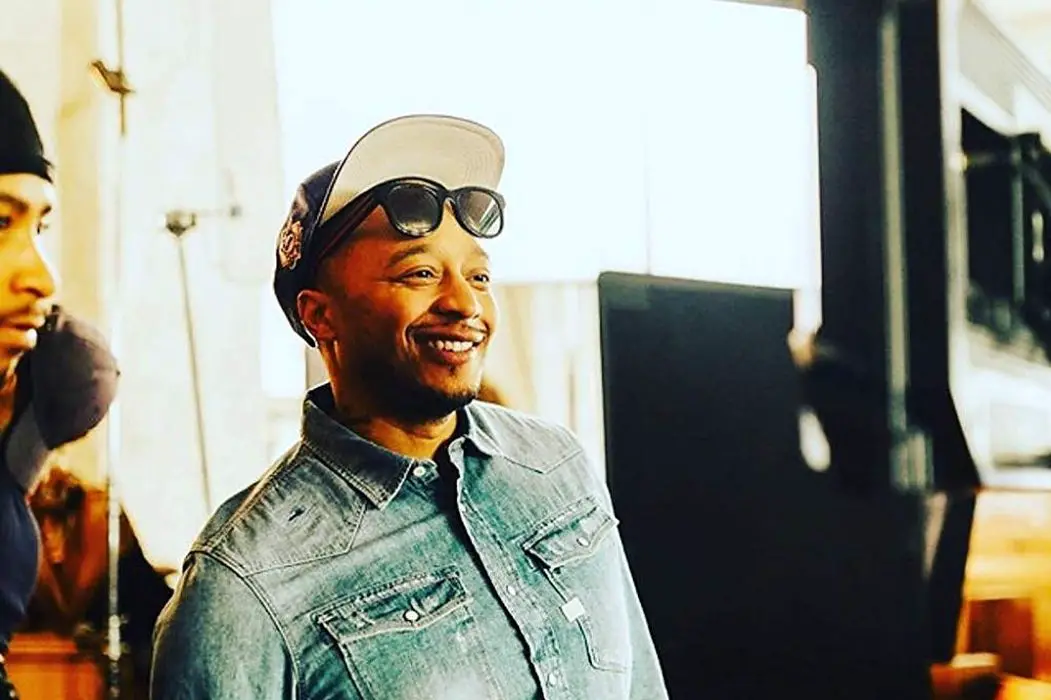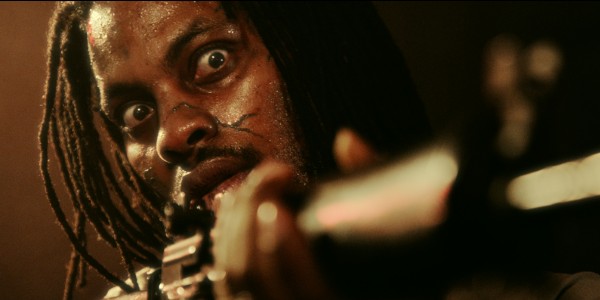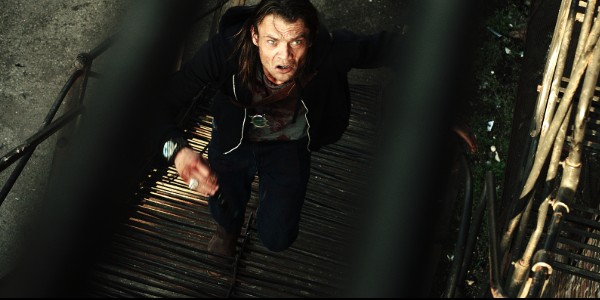Interview With Director Morocco Vaughn, Urban Thriller Auteur On The Rise

Jim Dixon retired from practicing law not a moment too…
Morocco Vaughn, director of the very gritty new horror thriller Mollywood, has a friendly voice and an easy laugh that completely belie the tone of the movie, which deals with a psychotic killer masquerading as a drug dealer in the inner city of Chicago to lure victims. How did the music video director get involved with the project?
“Me and the writer [Ken Hoyd] go back, and I made a promise to him that I would direct his first film,” Vaughn says. “He found a budget and he called me. He dragged me into the ring with him.” [Laughs] Although Vaughn himself is credited with “additional writing.” What did that consist of?
“I had to change the beginning, middle and the end. [Laughs] We ran into some—I won’t even call them complications—I will call them brick walls, with production—we actually lost some actors and things like that. We had to come up with a new ending, and in order to come up with a new ending I had to create a new beginning, and in order to make those things work I had to throw in a little piece in the middle.”
A “Cultural Melting” Pot of a Cast
The movie is set in, and apparently was largely shot in Chicago. Mollywood is populated with a fascinating cast of unknowns. Chicago has a famously vibrant theater scene. Was the cast local?
“We actually had a lot of people locally but the main—all of the main characters are from different parts of the country. Micah Fitzgerald who plays Chase is from the Los Angeles area. The same with Vinicius Machado, he’s actually a Brazilian, who has a background in theater and comes from the LA area as well. Waka Flocka who plays Bijou is from Atlanta. Billy Dec who plays Rush is Philippino and white, he’s from Chicago. So we had kinda a cultural melting pot as you’d call it cast-wise. But yeah, I wish we had more Chicago actors as we continue with these next projects. I enjoyed the cast,” he says.

It seems to be that the urban, inner city setting of Mollywood is practically a character in the movie itself. How important does he think that is? “It was very important,” he says. “I’m from Chicago so I think about the race scene, I think about Winter Park, Lincoln Park, some of the areas in Chicago, and I wanted to paint a different picture. Because when we think about partying and raving, it’s just happiness involved. I wanted to think about the darker elements that might take place and I wanted to give the people who enjoy that culture their own scare.”
Mollywood invites comparisons to vintage thrillers, maybe particularly The Silence of the Lambs. Does Vaughn have any favorite thrillers or was this new territory for him?
A Fan of Thrillers
Vaughn is quick to answer. “Oh yeah, I’m like just a fan. Silence of the Lambs was one of my favorites, The Shining, I like more of the realistic horror thriller films because they actually scare me. When someone has a mask on and all that other stuff, those are more just entertaining. But killers or characters that I could actually see myself encountering, they are more scary. This character is real close to the guy up in Se7en, he has a mission, he’s sticking to his mission, but what I do like about the film is he gets to unravel as things go by.”
Micah Fitzgerald, as Chase, makes quite an impression just standing there in a hoodie like the Unabomber with no face. And he’s got an amazing speaking voice. “Oh yeah, his voice drove everything because you couldn’t see him,” Vaughn says. “I mean I hid him behind sunglasses, I used objects to obstruct his face when I could or have him turn away from the camera. His voice is the motivating factor to give you curiosity throughout most of the film.
The Duality of Good and Evil
At the end of the movie there is some discussion of the symmetry between Mollywood’s antagonists. Does he feel that was an important element to the story—that these two guys have something in common?
“I believe it’s just the duality. I think in order to have evil there has to be good and one person isn’t necessarily one or the other, it’s just what side you are encountering. So Chase has parts of his personality that are good. And Zach, who is the protagonist is trying to capture him, he has his faults—he’s not an angel either. I think that plays more to the believability I get out of trying to make the good guy and the bad guy and I’m able to tell the story.”

How long did he have to shoot the movie? “The movie was broken up. Principal photography was probably about 17 days and we ended up doing about two pickup shoots. So altogether it was probably about 24 days of shooting but it was broken up…Every day that you get in production is a an opportunity to make a movie work or not work and yeah, budget-wise coming from a music video background, I am used to having to make stuff happen in one or two days. And I can pack a lot into those one or two days, but when you’re dealing with a movie it’s a marathon compared to a sprint. You’ve got to be able to keep going, so you can’t spend $50,000 in one day you’ve got to piece it out, you know what I mean?”
There is some graphic violence in the movie which is handled very unflinchingly. Is it difficult to shoot scenes like that?
“Light Horror”
Vaughn laughs at this. “Oh no man, this is light, this is light horror man. This is a thriller with horror elements. I wish I could go Texas Chain Saw. It was actually fun and I wish I had more of it. I had great special effects people. And it was a new territory for me. So, I will say that it was challenging. Understanding exactly how to capture the action on a limited budget because once we bloody up the hospital gown, we don’t have two or three more to go through, you know what I mean. Once someone gets shot with a blood pack, his shirt is gone. So because we’ve got a budget that is finite, you gotta know what you’re doing there. So that was about the biggest challenge with those types of scenes—trying to get the most bang for my buck.”
The cinematography by Camrin Petramale in Mollywood is remarkable. It looks to have been shot at night, yet with very vibrant colors.
The Palettes of Digital
Vaughn says: “Yeah, let me give my cinematography department all the credit there, because they created some great looks and some great palettes. And then let me give my colorist, J.P. [John Petersen] down at Moonshine [Post-Production Studio, Atlanta, Georgia], they do post-production. He did an amazing job of making those colors pop, even at night. So sometimes time-wise you can look and know it’s midnight out, but you can see everything astonishingly well. Even in the blacks there might be reds. So yeah, he did a great job.”
Was the movie shot on digital? “Yes it was. I used an Arri Alexa Mini camera,” Vaughn says. Digital has revolutionized the whole landscape. Can these cameras can work with much less light than the old film cameras could?
“Oh yeah, of course,” he answers. “When you used to look at old behind-the-scenes, that’s why you see those big, lights taking up the whole street. These cameras can work in lower light levels and particularly that camera, the Arri Alexa, is revolutionizing the film-making process. I think they’ve got like 70 to 80 percent of those films that were nominated for Academy Awards this year were all shot on Alexa. Digital is where I entered filmmaking at. Most of my music videos, the first film that I shot I actually used the same camera that George Lucas used in Star Wars back then. HD is something different. I think it actually went past them. And I know a lot of purists would argue with me about that, but the latitude that you can get out of light and what you can do in post-production is just unparalleled.”
Evolution of a Young Filmmaker
Was film making something he wanted to do from childhood on? There’s no hesitation in his answer. “Oh yeah, I actually started going to school at Columbia College in Chicago summer semesters when I was still in high school, so I started go ing there when I was 16 years old. When I used to watch movies, I used to just be fascinated by how you could alter reality. I used to have VHF tapes littering my whole living room—we’d be taping stuff from HBO and watching it over and over again. I was intrigued by the process. And so when high school was ending, or about to end, it’s the first thing I thought about, like, what if I could make movies and that’s kind of been my path. I detoured and started doing music videos because I couldn’t afford to finish college and the music videos gave me the confidence to pursue film. Ironically, eight years into a music video career I got this opportunity to shoot my first film.”
What were some of the movies that made a big impression on him when he was a teenager?
“Inside of the genre of horror, I would say The Shining. The Shining used to come on TV and I would be scared of it. From that fear it created interest. Candyman was another film, which I heard they are making a remake of right now, was a film that intrigued me as well when I was younger. I like psychological thrillers the most. I like films like Inception, anything that plays with reality. The Matrix, it has me looking at the world differently after I leave the movie theaters. Those are my favorite types of films,” he says.
Vaughn is from Chicago and the movie is set in Chicago. The credits also list some shooting in Atlanta. “Yeah,” he says. “A very small portion. The warehouse scene where you see the character Bijoux [played by Waka Flocka Flame] shoot up everything with the M-16, that was shot in Atlanta.”
Shooting Guns in Chicago
Admittedly, it must be fun to do something where you get to shoot off a lot of guns on the set. “Oh man, yes. The kid inside of me—the pyro and the gun play—man, that’s what we dream about as filmmakers, and being able to do it—in Chicago, to let off a gun in the middle of the west side and to have police permits to be able to do it? Man, that was a shining moment of movie making. [Laughs]”
So, what’s next for Morocco Vaughn? “I am working on a film called Outside Looking In. I just finished the script and I’m looking for money.” The door is left open for a sequel at the end of the movie. Is that something anyone is thinking about? “Oh yeah, well we – when Chase’s character grew on us in the editing room, that’s what motivated us to use that ending is – you didn’t get to see a lot of this guy, you know, half of the film we didn’t show his face and then once you got into him, you know, the film was almost over. So yeah, I think the audiences, if they like this enough they could try to tolerate a Part II.”
Mollywood is now available on digital and On Demand.
Does content like this matter to you?
Become a Member and support film journalism. Unlock access to all of Film Inquiry`s great articles. Join a community of like-minded readers who are passionate about cinema - get access to our private members Network, give back to independent filmmakers, and more.
Jim Dixon retired from practicing law not a moment too soon, and now works as a freelance writer and film critic. A lifelong and unrepentant movie geek, he firmly believes that everything you need to know in life you can learn at the movies. He lives in upstate New York.












